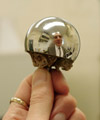October
Cobalt ions found to trigger the body’s immune system

Metal ions released by failing metal-on-metal (MoM) hip joint replacements can trigger an immune response similar to that caused by bacterial infections, Newcastle experts have found.
Research led by Newcastle University has revealed that cobalt ions can activate a crucial component of the body’s innate immune system - known as Toll-like receptor 4 (TLR4).
Mistaking the minute metal particles for bacteria, the white blood cells attack, secreting chemicals that can cause inflammatory lesions, termed pseudotumours, around the joint.
Like most immune responses, TLR4 activation varies between individuals which may explain why some patients have reacted more severely than others to the MoM replacement hips. This reaction by the body has led to some MoM hip replacements having to be removed.
Publishing their findings online today in the academic journal Annals of the Rheumatic Diseases, the team from Newcastle University and the Newcastle upon Tyne Hospitals NHS Foundation Trust, say the research provides the first explanation for the chronic inflammation and tissue damage that is seen in some patients with failed MoM joints.
“Until now we haven’t really understood the biological process of why this was happening,” explains Dr Alison Tyson-Capper, a Senior Lecturer and Molecular Biologist at Newcastle University who led the research together with John Kirby, a Professor of Immunobiology at Newcastle University.
“Although it’s still early days with this research programme,” says Dr Tyson-Capper, “our study shows for the first time the cellular mechanism as to how metal ions, in this case cobalt, can induce inflammation and this may explain why some patients react more severely than others to the MoM joints. TLR4 activation is driven by our genes and varies between individuals, so pseudotumour formation and subsequent joint failure will be different for every patient.”
Professor John Kirby, Professor of Immunobiology, adds: “The next step will be to find a way to match patients to specific prosthetic materials and consider therapeutic intervention designed to dampen down the inflammatory pathways activated by metal ions.”
published on: 17 October 2012
